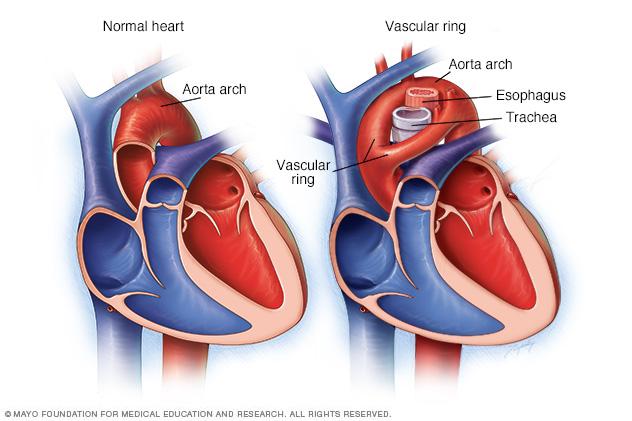Overview
A vascular ring is a heart condition present at birth. That means it's a congenital heart defect. In this condition, part of the body's main artery or its branches form a complete ring around the windpipe and the food swallowing tube.
- The body's main artery is called the aorta. A vascular ring affects the part of the aorta called the aortic arch and often its branches.
- The food swallowing tube is called the esophagus. It leads from the mouth to the stomach.
- The windpipe also is called the trachea.
A vascular ring can affect breathing and swallowing. Surgery is usually needed to treat a vascular ring.
A related condition is a vascular sling. In this common condition, an extra blood vessel off the aorta goes behind the esophagus. It rarely needs treatment.

Symptoms
Some people with a vascular ring don't have symptoms. Sometimes symptoms aren't noticed until later in life.
Symptoms of a vascular ring may include:
- Wheezing.
- Coughing, especially coughing that is long-term, also called chronic, or doesn't go away after a cold.
- Noisy breathing.
- Shortness of breath with exercise.
- Heartburn.
- Frequent respiratory infections.
- Trouble swallowing.
- Spitting up.
- Choking.
- Difficulty eating. The person may prefer soft foods, eat slowly and chew thoroughly.
Some people with a vascular ring may be born with other heart conditions. Specific symptoms depend on the types of heart conditions present.
When to see a doctor
Congenital heart conditions such as vascular rings often are diagnosed before or soon after a child is born. If your baby has symptoms of a heart condition, call your child's healthcare professional. You may be sent to a doctor trained in heart diseases, called a cardiologist. Get help right away if your baby has trouble breathing.
Call your baby's healthcare professional if your child has symptoms of a vascular ring, including:
- Coughing.
- Wheezing.
- Noisy breathing.
- Difficulty feeding and swallowing.
Causes
The exact cause of vascular rings is not known. Congenital heart conditions happen as a baby, also called a fetus, is growing in the womb during pregnancy.
Some things that may play a role in the development of congenital heart conditions are:
- Gene changes.
- Some medicines.
- Some health conditions.
- Lifestyle choices, including smoking.
- Things in your environment.
Risk factors
What increases the risk of vascular rings is not well known. Possible risk factors for vascular rings and other congenital heart conditions are:
- Genetics. Changes in some genes have been linked to congenital heart conditions. For example, people with Down syndrome often are born with heart conditions.
- Diabetes. Having type 1 or type 2 diabetes during pregnancy may change how the unborn baby's heart forms. But diabetes that develops during pregnancy doesn't typically increase a baby's risk of congenital heart conditions.
- Rubella, also called German measles. Having rubella during pregnancy can cause harmful changes in an unborn baby's heart. A blood test can be done before pregnancy to see if you're immune to rubella. A vaccine is available for people who aren't immune.
- Some medicines. Taking some medicines during pregnancy may increase the risk of congenital heart conditions. Examples include lithium (Lithobid) for bipolar disorder and isotretinoin (Claravis, Myorisan, others), which is used to treat acne. Talk with a healthcare professional about the medicines you take.
- Smoking. If you smoke, quit. Smoking during pregnancy or being around tobacco smoke increases the risk of some congenital heart conditions.
- Alcohol use. Drinking alcohol during pregnancy may increase the risk of heart conditions in the baby.
Diagnosis
To diagnose a vascular ring, a healthcare professional does a physical exam and asks questions about the symptoms.
Tests
Tests to diagnose a vascular ring may include:
- Chest X-ray. A chest X-ray is a picture of the heart and lungs. It can show changes in the windpipe that might suggest a vascular ring. The test also can tell which side of the body the aortic arch is on.
- Other imaging tests. These may include an echocardiogram, a CT angiogram or an MRI scan. Healthcare professionals can use these tests to plan treatment.
- Barium swallow. This test involves swallowing a liquid called barium. X-rays show how the liquid moves from the mouth to the stomach. The test can show changes in the structure of the esophagus that may be caused by a vascular ring.
- Upper endoscopy. A long, flexible tube with a camera is used to look at the esophagus. The device is called an endoscope. The healthcare professional inserts it through the mouth and into the throat. A tiny camera at the tip sends pictures to a video screen.
- Bronchoscopy. In this test, a healthcare professional inserts a small, flexible tube through the mouth or nose into the lungs. A light and a small camera attached to the tube show the inside of the windpipe and the lungs' airways. This test can tell if a vascular ring is pushing against the trachea.
Treatment
Surgery usually is done to treat a vascular ring that presses against the trachea or esophagus. Surgery also helps prevent complications.
During surgery, the surgeon splits the vascular ring to stop the blood vessel from pressing against the windpipe and food pipe. Depending on the type of vascular ring, one of the branches off the aorta may need to be moved. The specific type of surgery depends on the type of heart conditions present.
People born with vascular rings need regular health checkups for life to prevent complications. It's best to be cared for by a healthcare professional trained in congenital heart conditions. These types of doctors are called congenital cardiologists.
© 1998-2025 Mayo Foundation for Medical Education and Research (MFMER). All rights reserved. Terms of Use


